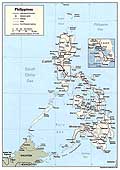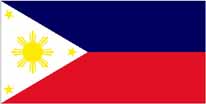-
-
- Philippines Map
|
-
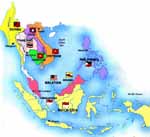
-
- Map of
- Southeast Asia
|
|
-
|
- latest picture: December 5, 2010
|
- Luzon (South) 11/5 -
11/17/2010
|
-
-
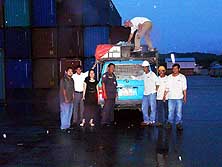
|
-
-
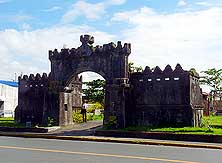
|
-
-
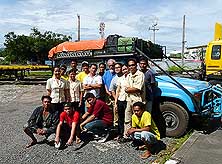
|
- 101
Friday, 11/5/2010: We made it!
- In the rain at dusk our LandCruiser was
- released from its 20th container in the port
- of Subic Bay. Mrs. Dang Reyes and more
- helpful hands pose for a welcome picture
|
- 102
The “Spanish Gate” – the Westgate
- – was the entrance to the original Spanish
- Naval Base in Subic Bay, which was
- taken over at the turn of the century by
- the Americans. Today Subic Bay is a
- Philippine Freeport Zone
|
- 103
Remembrance photo with the team
- of our shipping agent, Portland Marine
- Services Inc. in Subic Bay. The Manager,
- Ms. Dang Reyes, tried to remove all the
- bureaucratic hurdles to smoothen the
- release of our LandCruiser from the port
|
-
- A glimmer of hope on the horizon? We are grasping at the last straws when we meet Indai,
a Filipino lady in the Lutheran Guesthouse in Goroka in Papua
New Guinea. She is working for the United Nations in conflict areas like Darfur,
Afghanistan and now PNG and offers us spontaneously to make contact with her influential
friends in the Philippines should we not succeed to obtain the extremely difficult entry
permit for our LandCruiser . And we do not succeed. Thus we contact her shortly after, the
countdown for our car to exit Papua New Guinea having already started: In three weeks time
we will have to set the course for its next destination: Either the Philippines or Sri Lanka!
-
- And once more, a short, but intensive chance acquaintanceship gets the ball rolling
– and it is rolling fast. Indai’s intervention and friends on a ministerial
level in Manila go far out of their way to assist us – and miraculously within the
very short time available, soon a breakthrough seems in sight. Will our second attempt to
discover this country with our own car finally work out? But it is still too early to
jubilate, not all the permits from Manila are issued yet. Our chances that we get an
exemption from paying duty, tax and a bond from the Ministry of Finance are only 80% to
90% according to Mr. Willy from our shipping agent Soriamont, who is eager to make things
work for us – quite contrary to Toyota who does not even have the politeness to
answer a question we asked them by email.
|
-
-
-
-
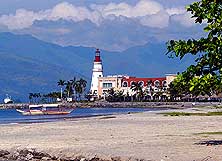
|
-
-
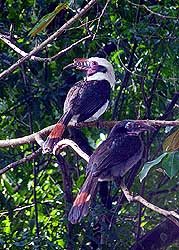
|
-
-
-
-
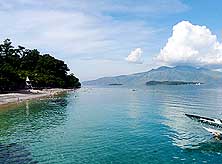
|
- 104
The Lighthouse Marina Resort
- – a landmark boutique hotel
- along the Moonbay Marina
|
- 105
Visitors at breakfast: A Luzon
- Tarictic Hornbill pair regularly comes
- to rest at the same tree at the Subic Bay
- Homestay, where we stayed for one week
|
- 106
Beach at the
- Camayan Beach Resort
|
-
- This percentage is sufficient for us to instruct our agent in Papua
New Guinea per email on the last day before the ship is lifting anchor in the port of
Lae to change the destination in the Bill of Lading from Sri
Lanka to the Philippines. We are ready to take a certain risk – risks belong to
our adventure. At this time, we are already in the Sultanate of Brunei
on the island of Borneo visiting our friends Julie and Ruedi for a couple of days. We got
to know them on our trip through Borneo in 2006 and feast
once more on Raclette, the Swiss cheese specialty. Early morning of November 2nd, it is
already time again to bid farewell. Ruedi drives us over the border to Miri in Sarawak, where we board AirAsia and fly via Kota
Kinabalu in Sabah to the Philippines to join our
LandCruiser. Three hours later, we land at Clark Airport, the budget air terminal near
Angeles on the island of Luzon. Immigration and customs are fast. The free “visa on
arrival” allows us to remain in the country for 21 days.
-
- Outside of the airport, Nathan’s parents Barry and Wendy from ‘Subic Bay Home
Stay’, which we booked via internet, are welcoming us. On the new express road
through lush rural scenery, it takes us only an hour to drive the 50 miles to Subic Bay,
where the container with our LandCruiser was unloaded in its port two days ago. Subic Bay
was a former US Naval Base, returned to the Philippines in 1991 together with the Clark
Air Force Base. In the meantime, both became a Free Port Zone, customs wise separated from
the rest of the Philippines, with duty free shops, supermarkets, restaurants, casinos and
expensive hotels and – over all – checkpoints at every corner.
|
-
-
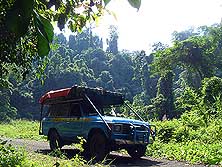
|
-
-
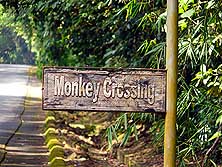
|
-
-
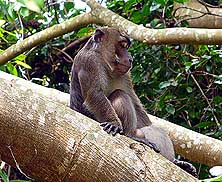
|
- 107
We drive through pristine jungle,
- which still covers a large part
- of the Subic Bay Freeport Zone …..
|
- 108
..... where road signs draw our
- attention to the special inhabitants .....
|
- 109
..... having a peaceful home here
|
-
- Next morning, on Wednesday, we make contact with Mrs. Dang, the manager of our broker
‘Portland Marine Services’, in order to start with the release procedure. Two
days later, on Friday at 6.15pm – it is already dark and it rains – we get her
phone call saying that she is on her way to fetch us; we are allowed to drive our
LandCruiser out of the port! What a surprise! Everyone seems to work overtime; everything
is handled smoothly and kindly. People are smiling and nobody even wants to have a glimpse
into our fully loaded LandCruiser. However, we are soon informed that our car had
succeeded only half of the hurdles and that we had not yet the final go-ahead to visit the
whole country. We are only allowed to move freely around the 20 miles Free Port Zone, but
in order to exit it we still need further stamps and signatures. And today is a Friday,
hence we are stuck in the “SBFZ“ until mid-week!
-
- It is not an issue though. During the American area logging was strictly banned, the
Free Port Zone being now largely covered with pristine forest, reclaiming more and more of
the base. It is a joyous feeling to crisscross the labyrinth of shady little forest roads,
where the green foliage is already sprawling on the forgotten paths, where the branches
are cracking from the rampaging baboons and where the colorful butterflies are flattering
around us. There are also some theme parks like ocean adventure and animal safari though,
but they do not attract us. And in our clean ‘Subic Bay Homestay’ in the green
we feel comfortable. The room costing Peso 2’300 (US$54) is not cheap, but we
appreciate having a fridge and a coffee making facility – not so much the microwave.
However the breakfast is included, which is always very assorted and tasty. We also like
to watch every morning a hornbill pair that settles always on the same branch while we are
having coffee.
|
-
-
-
-
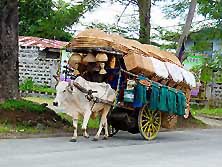
|
-
-
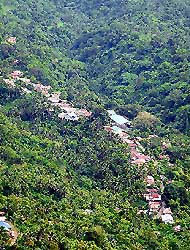
|
-
-
-
-
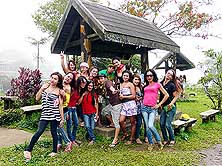
|
- 110
Traditional and nostalgic: A mean
- of transport with wickerwork. On our
- way to Lake Taal in the South of Luzon
- we encounter quite a number of them
|
- 111
From “People’s Park“ in Tagaytay
- at Lake Taal – the highest hill in the
- region – we enjoy a fine view over
- a village nestling in the forest …..
|
- 112
….. a group of students are
- enjoying themselves and the views too
|
-
- Next Wednesday, exactly after ten days, all the car papers are ready. In the meantime we
were also able to extend just across the river at the Immigration in Olangapo our 21 days
stay to 59 days for Peso 3’000 (US$70) each. Finally, we are ready to hit the road!
There is only one more obstacle to overcome: The exit control gate of the Free Port Zone.
But Mrs. Dang is paving also this way for us - the „Philippines way“: With our
bunch of documents she disappears behind a door at the checkpoint and we are convinced
that also there some dollars of the so-called “representation fees” (bribe
money), which are a substantial part of our paid bill of US$ 1’384, are distributed.
This is the way how most things work in the Philippines, whether you like it or not.
Either you accept it, or you leave it and don’t need to come here!
-
- Then the gate opens for good and while everybody is waving (no wonder!) we are rolling
officially into our 168th country, into the archipelago of the 7’107 islands. It is
Thursday, November 11th, 11.11am. What a sense of achievement! 50 miles further, in
Angeles near the Clark Airport – the former US Airbase – we already make our
first overnight stop. Not because of the place itself, where in front of each of the
plentiful bars at least half a dozen juvenile girls in sexy outfits compete to attract
customers – similar to Pattaya in Thailand. It’s
said that currently around 10’000 of them are earning their living in the sex
business – apparently during the deployment of the US Air Force the number was ten
times higher. Today it’s not anymore alive with GI’s but with retired Westerners
who swarm out of bars and hotels hand in hand with girls still looking like
schoolchildren.
|
-
-
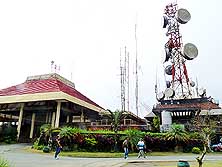
|
-
-
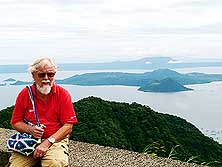
|
-
-
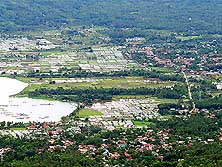
|
- 113
Little is left of the former glory of the
- guesthouse in Tagaytay – built by President
- Marcos for a planned visit of President
- Reagan. Everything is in a desolate state
|
- 114
Emil poses for a picture at
- Lake Taal with its 1’000 ft high Taal
- Volcano – a crater within a lake
|
- 115
Rice fields spread to
- the shores of Lake Taal
|
-
- For us Angeles is the place where we have to set the course: North or South. It will be
South as we visited Northern Luzon already in February 2008
with a “Kia”, a rented car during 13 days for US$28/day, while our LandCruiser
was sailing from Hong Kong to New
Zealand. But unfortunately, there is only one way South and it leads through the
always hopelessly congested mega city of Manila – everybody’s nightmare! We
decide to wait until Sunday when the traffic is less intense and when we surprisingly
manage to cross the capital without having even to stop once!
-
- Soon we realize that the Philippines cities are almost identical to the Indonesian: Lively, chaotic, congested, partly dirty,
noisy and polluted. The many slow motorbikes with sidecar are really hampering the
traffic. But also the fancy painted “jeepneys”, which poison the air and stop
everywhere, are contributing to the chaos. We are happy when mid afternoon we already
reach our today’s destination: Tagaytay at the Taal Crater Lake, on an altitude of
2’000ft.
|
-
-
-
-
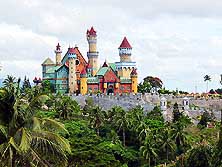
|
-
-
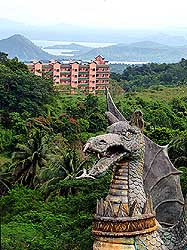
|
-
-
-
-
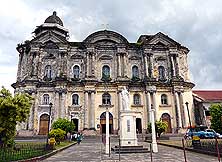
|
- 116
The castle of the “Fantasy
- World” theme park in Wyndham
- Hills on our descent from Tagaytay
- to Taal City remembers of the
- “Cinderella Castle” in Disneyland
|
- 117
View from the “Fantasy
- World” over Lake Taal
|
- 118
The “Basilica of St Martin de Tours“
- in Taal City – one of the best preserved
- sites of the Spanish colonial era – is one
- of the largest Catholic churches in Asia.
- Its interior is currently under renovation
|
-
- The temperature is refreshing and we head straight away to the „People’s
Park“ – the highest hill in the region – where we enjoy a sweeping view
over the imposing crater lake with its 1’000ft. high, still active Taal crater –
a crater within a lake – and the rice fields spreading to the river banks. It is an
ideal spot for a picnic. Here, we are actually standing on historic ground. The
“villa” was built years ago by President Marcos for a planned visit of President
Reagan. Unfortunately, there is not much left of its former glory. The decay is visible
around every corner.
-
- After two days of comfortable temperatures we continue to the historic small town of
Taal with its restored colonial buildings from the Spanish area and its massive Basilica
– said to be the biggest in Asia. Its interior is
currently under renovation. The many souvenir shops under colorful tarps are quiet on this
weekday, as the main business is done during the weekend. Then we head East, past Lipa
City to Lucena City and towards the Southeastern tip of Luzon with its imposing volcanoes
– the Philippines count 200 volcanoes.
|
-
-
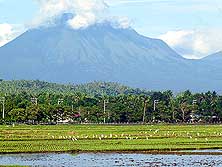
|
-
-
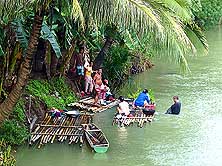
|
-
-
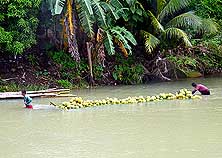
|
- 119
Rural charm at Tiaong
- East of Lipa City
|
- 120
River east of Lucena City on the way
- to Pagbilao: People washing themselves
- and their clothes on bamboo rafts …..
|
- 121
..... bamboo rafts serve also as
- mean of transport for coconuts on a river
|
-
- Shortly after Lucena, we are not anymore so sure if it’s worth to struggle with the
deteriorating road condition for a further 300 miles when trucks push constantly from
behind and the houses, mostly lining both sides along the highway, prevent us to have a
view at the nature at all. At a bridge exactly 13 miles East of Lucena where people are
washing on bamboo rafts, Emil throws in the towel: We turn around and decide to drive back
to the port city of Batangas to board there the car ferry to the smaller and less
populated Southerly island of Mindoro. Choosing this way to the South, called ‚Strong
Republic Nautical Highway’ (what a strange name!), we don’t have to
“survive” the terror of trucks for a second time that we already experienced on
Indonesia’s Sumatra.
-
- Shortly before 2pm, we arrive at the pier and inquire about the next sailing to Puerto
Galera on Mindoro. “At two”, is the answer! Aren’t we lucky? Five minutes
later, the “MV Reina de las Flores“ of the Monte Negro Shipping Lines – a
relatively modern, clean Western style ferry – lifts its ramp. We pay Peso 1’500
(US$34), for the three-hour-journey and enjoy the passing island’s scenery with its
scattered houses or occasionally a bungalow resort wedged between the steep green hills
and the blue sea.
|
-
-
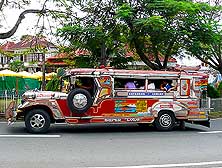
|
-
-
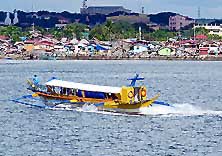
|
-
-
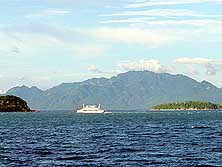
|
- 122
„Jeepneys“ – public motor vehicles
- – with their colorful designs are a delightful
- sight everywhere, but sometimes also a
- nuisance as they stop everywhere and
- discharge often clouds of black diesel smoke
|
- 123
A „Bangka“ – a wooden boat
- with an outrigger – near the ferry
- terminal of Batangas in the South
- of Luzon Island. They work also
- for public transport
|
- 124
Ferries of any kind connect nearly
- all of the 7'107 Philippines islands. Here a
- car ferry from Luzon to Mindoro within
- the frame of the ”Strong Republic
- Nautical Highway“ (or also called
- “Western Nautical Highway”), which runs
- from Manila to Dipolog on Mindanao
|
-
|
- Island of Mindoro 11/17
- 12/3/2010
|
-
- After our arrival, we are looking straightaway for the two guesthouses we chose from the
internet – in vain, we just cannot find them. A Westerner follows us on a bicycle and
stops us. “Are you really coming from Zurich?” he asks us in Swiss dialect. It
is Ernst who is working with his wife Sonja already for many years in the Philippines for
the “OMF”, the Catholic “Overseas Mission Fellowship”. Much to our
surprise and excitement he tells us that we are not in Puerto Galera, but 30 miles East of
it – in Calapan. It turns out that all car ferries now call only this port, what is
nowhere shown and nobody is telling. Well, it doesn’t matter where we start
exploring; we just find it funny that everybody nodded when we asked in Batangas if the
ferry is leaving for Puerto Galera. Even if we are not in the right town, at least we are
still on the right island!
-
- Having met Ernst, we end up staying at the “OMF” guesthouse, beautifully
situated on a hill with a lovely view spreading to the sea and its islands. We get an airy
room with shower/toilet/breakfast and wi-fi for Peso 1’000 = US$22 and feel
comfortable. The other guests are catholic missionaries or bible translators who work
together with the “Summer Institute of Linguistic (SIL)” in Ukarumpa in Papua New Guinea, where a few weeks ago we also spent a couple
of nights. In Calapan, the capital of Mindoro Oriental, there is not much of interest. The
town does not differ from other Philippines cities: It is alike chaotic, polluted and
messy. Here we see additionally bicycle rickshaws again, which are now prohibited in
Manila.
|
-
-
-
-
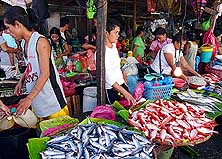
|
-
-
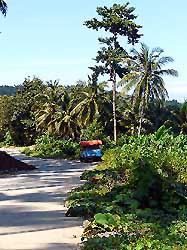
|
-
-
-
-
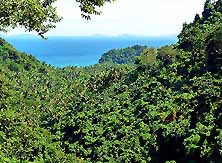
|
- 125
At the market in Calapan, the
- capital of „Mindoro Oriental“,
- fresh fish is plenty
|
- 126
On our way from Calapan
- to Puerto Galera in the West: It is
- a scenic 30 miles drive partly
- through the hills along the coast …..
|
- 127
.....
lush vegetation and the
- deep
blue sea invite us to take a
- picture.
Not for nothing it’s
- called
“Verde Island Passage”
|
-
- After three nights, we are finally driving towards our primary destination: Puerto
Galera situated more Westerly in the North of the island. The 30miles become the most
beautiful we have so far driven with our own car through this archipelago. Twisting and
turning, the newly built road meanders through lush vegetation, past modest villages,
where the omnipresent carpets of drying rice on the tarmac take half of the road.
Occasionally, the forest thins out. Then we have a glorious view of the coast. And as an
additional treat and the dot on the “i”, we pass the Tamaraw waterfalls that
rush from high up through the forest into a pool and further down the valley right besides
the road.
|
-
-
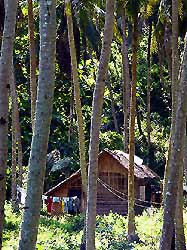
|
-
-
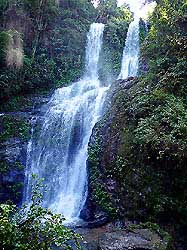
|
-
-
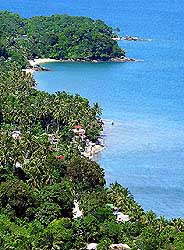
|
- 128
A peaceful living: A modest
- dwelling lonesome in a palm grove
|
- 129
The Tamaraw waterfalls
- drop from a forest creek into a
- pool just besides the road, nine
- miles short of Puerto Galera
|
- 130
Small settlements and
- white beaches dot the coast
- towards Puerto Galera
|
-
- Our first stop in Puerto Galera is Sabang Beach, popular with divers. Soon we realize
that this is not where we want to spend a couple of days: Hotels, bars, night clubs,
restaurants and souvenir shops have overtaken the whole place. Everything is so cramped,
making it difficult to even park our car. At least we find a sign leading to a small open
area acting as the only village parking. It costs 50 Peso (=US$1.14) to park. We stroll
through the narrow alleys and along the waterfront with its many dive shops and have lunch
at one of the just as many restaurants. But after that, we escape the crowd and drive West
along the lovely bay. The “White Beach” comes next. But again, we do not fall in
love with it. It is too busy and too overbuilt and for cars there is anyway no access.
|
-
-
-
-
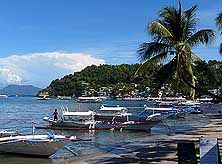
|
-
-
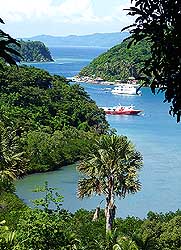
|
-
-
-
-
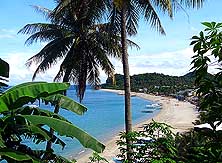
|
- 131
Sabang – another dive center
- – is one of the beaches surrounding
- Puerto Galera. It is very touristy
|
- 132
View over the picturesque sea
- harbor of Puerto Galera. Not long ago the
- car ferries from Batangas/Luzon arrived
- here – now they are sailing to Calapan
|
- 133
The „White Beach“ West of Puerto
- Galera is a popular weekend destination
- for people from Manila who escape their
- polluted city. Mostly they arrive on
- a Bangka from Batangas
|
-
- But at the following beach, the Aninuan Beach, we like it, and in a room on the 2nd
floor of the main building of the ‘Tamaraw Beach Resort’ we have everything we
need, including a fridge (important for our Gin Tonic!), TV and wireless in the lobby and
above all a beautiful view from the veranda. The food on the cozy beach restaurant is
tasty, but unfortunately the serving is much too small. During the week it is wonderfully
quiet. Weekends however, it gets pretty busy with families and Westeners with their local
“sweethearts” from Manila.
|
-
-
-
-
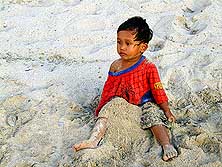
|
-
-
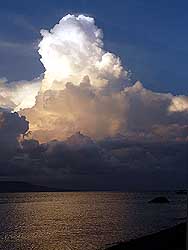
|
-
-
-
-
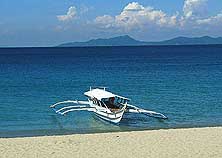
|
- 134
A child sitting quietly in
- the sand at Aninuan Beach
|
- 135
The setting sun is coloring the
- towering cloud at Aninuan Beach
|
- 136
A wooden boat with outriggers, called
- Bangka, is waiting for guests at “White Beach”
|
-
- „Where are your four children?“, a hotel employee asks us on our second day.
Once more we have been mistaken with the Zapp family from Argentina, which – with the
help of their embassy – made it also temporarily into the Philippines with their 1928
“Graham Page” vintage car one week before us and therefore got some TV coverage.
We find it astonishing because we really have absolutely nothing in common: Neither the
car, nor the children, nor the age. On the other hand is it not weird? Since over 40 years
no foreign car was admitted anymore to the Philippines, and suddenly there are two parties
almost simultaneously? We tried to make contact several times with Herman Zapp by email
and would have loved to meet his family. But all our attempts are not answered, a strange
and abnormal behavior between car travelers. May be he is not so pleased that he is not
the only successful one? Whatever the reason might be: We admire his 10-year-journey with
his “old-timer”, which started with only the couple and increased to six in the
meantime! Traveling with four children is for sure a special challenge too, particularly
– according to the remarks on Facebook and his website – because the necessary
means are obviously scarce!
|
-
-
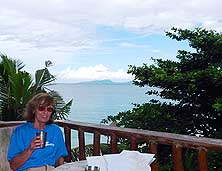
|
-
-
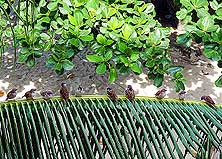
|
-
-
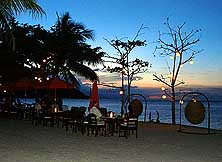
|
- 137
Liliana is enjoying the lovely sea
- view and a gin tonic from the balcony
- of our room at the Tamaraw Beach
- Resort at Aninuan Beach …..
|
- 138
..... curious sparrows are
- always around and are not even
- afraid to come into the room
|
- 139
Doesn’t look the Aninuan Beach
- Resort tempting for a romantic dinner?
|
-
- From our planned two beach days we finally stay eleven, including three days when Emil
falls ill with a sore throat and some fever. When we hit the road again and return to
Calapan, the car ferry place, the sun is shining from a blue sky. Along the road people
are raking up the rice that they spread out to dry in the morning and pack it into big
white plastic bags. Either they are loaded to nostalgic ox carts or to folkloristic
painted “jeepneys” and transported to one of the many rice mills lining the
street of Calapan that seems to be a collection point. Hundreds of bags are piled up in
the depots and rice is still put out to dry in a large scale. There are three harvests a
year, which is just enough to meet the needs of the own population, we are told. There is
not enough for export. What is the country exporting? Manpower – worldwide three
millions! We remember that on the Arabian Peninsula the house maids are often from the
Philippines and their work is appreciated, while on shipping vessels a lot of Filipinos
work as crew members sailing the oceans.
|
-
-
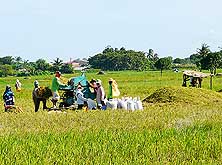
|
-
-
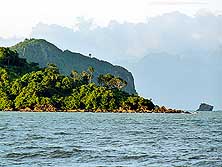
|
-
-
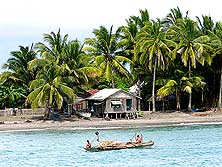
|
- 140
Farmers are threshing their rice
- outside Calapan. There are three
- harvests a year what just covers
- barely the demand of the country
|
- 141
Lovely evening mood over one
- of the offshore islands North of the
- Parang Beach Resort in Calapan
|
- 142
The island of Mindoro bids farewell
- with an idyllic coastal picture when we
- sail from the ferry terminal of Roxas in
- the Southeast to the next island – Panay
|
-
- When we leave Calapan after a night’s stop, we follow once more the “Strong
Republic Nautical Highway” – the interlocking road-sea-route connecting the
islands of Luzon, Mindoro, the Visayas and Mindanao with ro-ro-ferries. Its construction
was decided only three years ago by former President Gloria Macapagal-Arroyo. Before the
islands were accessible only either by plane or ships, while cars had to be transported
separately as cargo. However, the road is not entirely completed yet; at least 20 miles
outside of Calapan are still under construction, taking us four hours for the 80 miles to
Roxas, the ferry terminal to the next neighbor island of Panay. We arrive there at 3pm and
despite that the next ferry was already leaving at 4pm, we prefer to spend the night still
on this side. The journey will take 3½ hours what means that we would arrive in the dark,
what we do not like and avoid always if possible.
-
- Looking for a spot along the sea shore to spend the rest of the afternoon, we end up at
a residential area at Catalina Beach, where Nori approaches us and offers us spontaneously
his beach house. Little by little his entire extended family shows up and we learn a lot
about the country’s politics. He invites us to stay as long as we want. Having
however restarted our ”locomotive” only two days ago in Puerto Galera, we are
not yet in the mood for another break. Therefore, next morning, we drive our LandCruiser
directly into the hull of the ferry bound for Panay. The fare for the 3½ hour journey of
our second island hopping is Peso 3’500 (=US$80).
|
- Island of Panay 12/3 -
12/5/2010
|
-
- Caticlan, the ferry port of Northwestern Panay and departure port for the tourist island
of Boracay, announces itself with a palm-lined coast covered with outrigger canoes and
huts half hidden among palm trees. Left of it stretches the long sandy beach of Boracay
– the pearl of the Philippines. Unfortunately, its prices do not conform to our
budget, though Emil is still hesitant and argues: “It is like being in Peru and not
visiting the Inca ruins of Machu Picchu. Boracay is undeniably THE holiday paradise of the
Philippines”. But he also agrees that we do not necessarily have to go there, where
everything is more expensive and therefore exceeds by far our means and secondly the
questions comes up whether it is really worth it. Thus we check in at the Airport Hotel
for one night. On the airstrip right across the fence one prop-plane after the other is
landing. They carry well-off guests from Manila and the island of Cebu who are received at the welcome center and escorted to
the tourist paradise of Boracay.
|
-
-
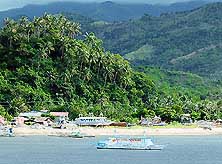
|
-
-
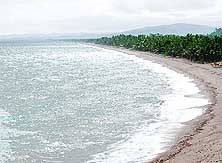
|
-
-
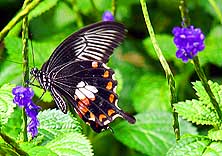
|
- 143
We are approaching Caticlan on the
- island of Panay that belongs to the Visayas.
- Here is the starting point to the Island of
- Boracay, one of the most famous and most
- expensive Philippines tourist destinations
|
- 144
Shortly after Caticlan, a remote
- sand beach is appearing below us
- along the Northern coastal road …..
|
- 145
..... and on the other side of the
- road, a colorful butterfly, a black
- bodied swallowtail (Papilio Polytes
- Ledebouria), is fluttering from blossom
- to blossom when we make a photo stop
|
-
- Next morning, we leave busy Caticlan and follow once more the “Strong Republic
Nautical Highway” along the West coast to the South. The scenery becomes more rural
and more peaceful. After the dirty towns, the clean, well tended and in much green and
blooming flowers embedded villages are a treat for our eyes. We enjoy the lush rice fields
stretching to the sea on one and to the hills on the other side of the road. Now and then,
a cluster of Nipa huts under high rising palm trees appear in a rice fields. Simple bamboo
huts of fishermen families nestle along the seashore. The beaches are lined with colorful
outrigger canoes. Rice is spread out in large scale to dry here too. Together with fish,
it is the main diet of the population. Goats, cows and water buffalos are part of the
scenery. It is an island life that has a great appeal and represents also how foreigners
are picturing it. Much too fast we reach San Jose de Buenavista in the South where we turn
inland on a windy mountain road towards the West and Iloilo.
|
-
-
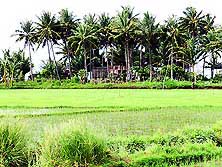
|
-
-
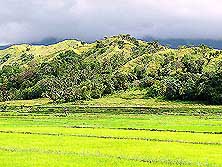
|
-
-
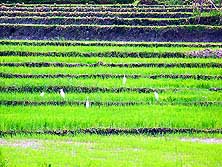
|
- 146
|
- 147
|
- 148
|
- Paddy fields dominate on the West coast where we follow the „Western Strong
Republic Nautical Highway“,
- the interlocking road-sea-route with ro-ro-ferries between the islands of Luzon,
Mindoro, the Visayas and Mindanao
|
-
- In the Southern part or Panay the evidences of the Spanish colonial area accumulate.
There are still quite a number of century old churches. The first one we visit has a
rather “military” character and dates back to 1869. It stands in San Joaquin.
According to “Insight Guides”, the attraction is a relief of the historic battle
of Tetuan, depicting Spanish armed forces fighting back the Moors in Morocco.
Unfortunately, there is not much left of its old glory. What we see is only a yellowing
facade and a battered relief. Exactly the opposite is the “Miagao Fortress
Church” lying 8 miles to the North. It belongs to the four Philippines churches
proclaimed by UNESCO as World Heritage Sites. We arrive towards the evening and like it
instantly. The main facade, flanked by two plain fortress towers, reveals an exotic relief
of a tropical fruit garden.
|
-
-
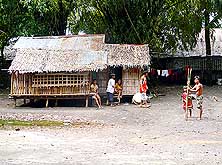
|
-
-
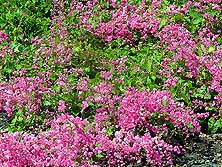
|
-
-
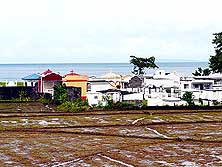
|
- 149
Daily life at a modest
- hut along the coast
|
- 150
Carpets of these purple
- flowers grow near the sandy
- beach at many places
|
- 151
A catholic cemetery sandwiched
- between a fallow rice field and the blue
- sea. The Roman Catholic Church is the
- biggest religious group in the Philippines
|
-
- Having driven today already 132 miles, we spontaneously decide to spend the night here.
Right behind the church, we find an aircon room – actually a whole apartment –
for Peso 1’500 (US$34). Next morning, the church bells ring already at 5am calling to
the holy mass. It is a Sunday. At 8am, we also hop over the street. The church is cramped
with devotees. People gather also outside at the open doors. From a stony bench under a
shady tree, we watch the church goers, from grandfathers to babies. Sweet are the small
girls, dressed like dolls, who try with still wobbly legs to make some walking attempts
Then, we return to our apartment, return the key and hit the road again – towards
Iloilo City.
|
-
-
-
-
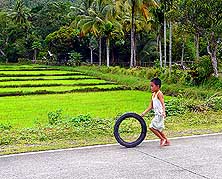
|
-
-
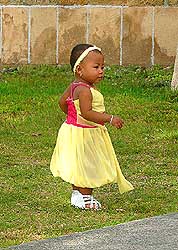
|
-
-
-
-
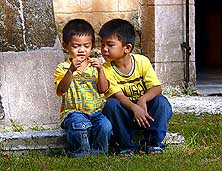
|
- 152
A boy in a rural area enjoys
- rolling a bicycle tire along the street
|
- 153
Doesn’t the little girl look
- adorable in her Sunday dress?
|
- 154
What are the two concocting?
|
-
- It suits well that it is a quiet Sunday for our visit of this half-a-million-city. First
of all, we are looking for the ferry terminal, mentioned in Lonely Planet in order to
investigate about the schedule to the island of Negros. We end up at a crammed part of the
harbor where people live in poverty and I am glad when we find our way out again. Whoever
we ask about this ferry terminal, we just get an answer in the negative. Also the security
personnel, dressed like generals and posted at every corner, cannot help us and often give
us false directions, just to have something said for not seeming ignorant. Only a woman
carrying a baby brings us finally a step further. She suddenly mentions the village
“Dumangas”. This place lies 15 miles to the North. Is this possible? Well, we
will have to check ourselves.
|
-
-
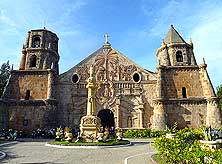
|
-
-
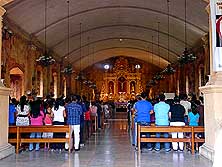
|
-
-
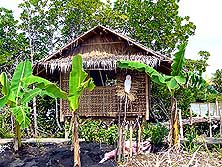
|
- 155
The Miagao Church – (Santo
- Tomas de Villanueva) – in the South-
- west of Panay was declared a UNESCO
- world heritage site. Flanked by two
- bleak stronghold towers, the facade of
- the main section shows a beautiful
- relief of a tropical fruit garden …..
|
- 156
..... Believers take part at the
- celebration of the Sunday mass
|
- 157
The Infant Jesus adorns a
- thatched hut between Iloilo City
- and Dumangas in the East of Panay
- as Christmas approaches
|
-
- Along a badly damaged coastal road belonging also to the ‚Strong Republic Nautical
Highway’, we crawl North towards Dumangas. The condition of the road shows once more
that – though the appropriate directives exist – its implementation is failing:
The project was started exuberantly but soon afterwards it gets forgotten again.
Cozy and airy eateries, built on stilts, line the road. All are empty. Why? We don’t
find out. While Emil needs to concentrate mainly on the dusty potholed road, I enjoy the
rural scenery passing by – the modest fishing settlements with the thatched huts and
outdoor kitchens with all its pots. At 1pm we reach Dumangas and arrive really at the
right place.
|
-
-
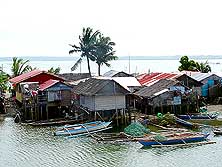
|
-
-
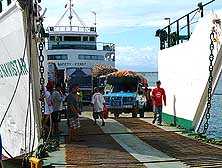
|
-
-
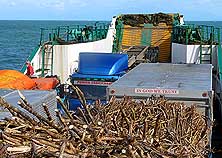
|
- 158
Small fishing village near Dumangas,
- the ferry port, where the ro-ro-ferries leave
- for Bacolod on the island of Negros .....
|
- 159
..... Emil is maneuvering our
- LandCruiser into the ferry leaving
- for Bacolod on Negros Island …..
|
- 160
..... and sits on the roof of our Land
- Cruiser for the two hour ride until the salt
- water fountains chase him away
|
-
- We learn that the next ferry to Bacolod on Negros is sailing at 2.30pm. Actually, we
only wanted to inquire about the departure times. But being already here and missing no
further special sights on Panay, we can as well hop to Negros
now. There is just time for a quick picnic consisting of bread, salami, cheese, olives and
a cold beer from our car’s fridge before Emil maneuvers onto the open ferry where
already trucks are parked carrying highly loaded sugar cane. Our parking spot is right
besides the ramp. During the following two hours we helplessly watch how our good old
LandCruiser – which is rusting anyway more and more – gets one salt water shower
after the other! The best way that the rust gets worse.
|
-
- More websites from the Philippines:
- 2nd Visit – Part
2: Islands of Negros –
Cebu with our vehicle from December 2010 to January 2011
- 2nd Visit – Part
3: Island of Bohol – Luzon (South)
with our vehicle in January 2011
- 1st Visit to the
Philippines: Luzon (North) without
vehicle in February 2008
|
![]()
